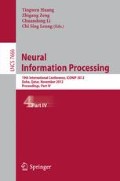Abstract
Stress is a major problem facing our world today and it is important to develop an understanding of how an average person responds to stress in a typical activity like reading. The aim for this paper is to determine whether an artificial neural network (ANN) using measures from stress response signals can be developed to recognize stress in reading text with stressful content. This paper proposes and tests a variety of ANNs that can be used to classify stress in reading using a novel set of stress response signals. It also proposes methods for ANNs to deal with hundreds of features derived from the response signals using a genetic algorithm (GA) based approach. Results show that ANNs using features optimized by GAs helped to select features for stress classification, dealt with corrupted signals and provided better classifications. ANNs using GAs were generated to exploit the time-varying nature of the signals and it was found to be the best method to classify stress compared to all the other ANNs.
Access this chapter
Tax calculation will be finalised at checkout
Purchases are for personal use only
Preview
Unable to display preview. Download preview PDF.
References
Selye, H.: The stress syndrome. The American Journal of Nursing 65, 97–99 (1965)
Hoffman-Goetz, L., Pedersen, B.K.: Exercise and the immune system: a model of the stress response. Immunology Today 15, 382–387 (1994)
The-American-Institute-of-Stress. America’s No. 1 Health Problem - Why is there more stress today? (August 05, 2010), http://www.stress.org/americas.htm
Lifeline-Australia (Stress Costs Taxpayer $300K Every Day (2009), http://www.lifeline.org.au
Liao, W., et al.: A real-time human stress monitoring system using dynamic bayesian network. In: Computer Vision and Pattern Recognition - Workshops. CVPR Workshops (2005)
Zhai, J., Barreto, A.: Stress recognition using non-invasive technology. In: Proceedings of the 19th International Florida Artificial Intelligence Research Society Conference FLAIRS, pp. 395–400 (2006)
Dou, Q.: An SVM ranking approach to stress assignment. University of Alberta (2009)
Labbé, E., et al.: Coping with stress: the effectiveness of different types of music. Applied Psychophysiology and Biofeedback 32, 163–168 (2007)
Healey, J.A., Picard, R.W.: Detecting stress during real-world driving tasks using physiological sensors. IEEE Transactions on Intelligent Transportation Systems 6, 156–166 (2005)
Scherer, S., et al.: Emotion recognition from speech: Stress experiment. In: Proceedings of the 6th International Language Resources and Evaluation (LREC 2008), Marrakech, Morocco (2008)
Sharma, N., Gedeon, T.: Stress Classification for Gender Bias in Reading. In: Lu, B.-L., Zhang, L., Kwok, J. (eds.) ICONIP 2011, Part III. LNCS, vol. 7064, pp. 348–355. Springer, Heidelberg (2011)
Goldberg, D.E.: Genetic algorithms in search, optimization, and machine learning. Addison-Wesley (1989)
Park, B.J., et al.: Feature selection on multi-physiological signals for emotion recognition. In: 2011 International Conference on Engineering and Industries (ICEI), Korea, pp. 1–6 (2011)
Niu, X., et al.: Research on genetic algorithm based on emotion recognition using physiological signals. In: 2011 International Conference on Computational Problem-Solving (ICCP), pp. 614–618 (2011)
Yacci, P.: Feature selection of microarray data using genetic algorithms and artificial neural networks. Rochester Institute of Technology (2009)
Golub, T.R., et al.: Molecular classification of cancer: class discovery and class prediction by gene expression monitoring. Science 286, 531–537 (1999)
Ferreira, P., et al.: License to chill!: how to empower users to cope with stress. In: Proceedings of the 5th Nordic Conference on Human-Computer Interaction: Building Bridges, pp. 123–132 (2008)
Dishman, R.K., et al.: Heart rate variability, trait anxiety, and perceived stress among physically fit men and women. International Journal of Psychophysiology 37, 121–133 (2000)
Author information
Authors and Affiliations
Editor information
Editors and Affiliations
Rights and permissions
Copyright information
© 2012 Springer-Verlag Berlin Heidelberg
About this paper
Cite this paper
Sharma, N., Gedeon, T. (2012). Artificial Neural Network Classification Models for Stress in Reading. In: Huang, T., Zeng, Z., Li, C., Leung, C.S. (eds) Neural Information Processing. ICONIP 2012. Lecture Notes in Computer Science, vol 7666. Springer, Berlin, Heidelberg. https://doi.org/10.1007/978-3-642-34478-7_48
Download citation
DOI: https://doi.org/10.1007/978-3-642-34478-7_48
Publisher Name: Springer, Berlin, Heidelberg
Print ISBN: 978-3-642-34477-0
Online ISBN: 978-3-642-34478-7
eBook Packages: Computer ScienceComputer Science (R0)

